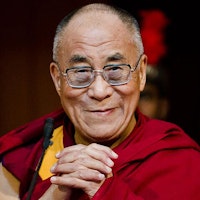It is my belief that if prayer, meditation and contemplation… are combined in daily practice, the effect on the practitioner’s mind and heart will be all the greater.
The Dalai Lama

An Inner Transformation
Topic: Virtue, Morality, & Ethics
It is my belief that if prayer, meditation and contemplation… are combined in daily practice, the effect on the practitioner’s mind and heart will be all the greater. One of the major aims and purposes of religious practice for the individual is an inner transformation from an undisciplined, untamed, and unfocused state of mind towards one that is disciplined, tamed and balanced… When meditation becomes an important part of your spiritual life, you are able to bring about this transformation in a more effective way.
Tenzin Gyatso, born on July 6, 1935, is known globally as the 14th Dalai Lama, the spiritual and former political leader of the Tibetan people. Born as Lhamo Thondup in a farming family in Taktser, Amdo, Tibet, he was recognized as the reincarnation of the 13th Dalai Lama, Thubten Gyatso, when he was just two years old. As the Dalai Lama, he holds the highest spiritual position within Tibetan Buddhism and is seen as a figure of great moral authority and influence. Following China's invasion of Tibet in 1950, he assumed full political power in 1950 but was forced into exile in India in 1959 after the failed Tibetan uprising against Chinese rule.
The Dalai Lama is renowned for his messages of peace, non-violence, inter-religious understanding, and compassion. He has authored numerous books and has lectured worldwide, becoming one of the most influential figures in the world of spirituality and philosophy. In recognition of his work for peace and non-violence, he was awarded the Nobel Peace Prize in 1989. Furthermore, his advocacy for the cultural and religious rights of the Tibetan people and his efforts to find a peaceful solution to the situation in Tibet through dialogue and understanding, rather than violence, have made him an internationally respected leader. Despite the political controversies and challenges, he remains committed to promoting human values and harmony among the world's religious traditions.
Craig, Mary. The Pocket Dalai Lama. Shambhala Publications, Inc., 2017. pp. 36-38 [Tenzin Gyatso, The Fourteenth Dalai Lama].

The Dalai Lama
Theme: Virtue Is

Commentary on “An Inner Transformation” [Commentary]
The Dalai Lama explains that combining prayer, meditation, and contemplation in daily practice has a magnified effect on the practitioner’s mind and heart. In his words, the goal is a transformative journey from an “undisciplined, untamed, and unfocused state of mind” to one that is “disciplined, tamed, and balanced.”
The Dalai Lama says, “When meditation becomes an important part of your spiritual life, you are able to bring about this transformation in a more effective way.” In line with his belief, the daily practice of these three distinct but interconnected disciplines serves as a practical pathway for achieving a disciplined and balanced state of mind. The focus is on inner transformation, and according to the Dalai Lama, that transformation becomes more attainable and effective when these practices are combined.
Additional Dalai Lama Quotes
Resources
Related Quotes
Copyright © 2017 – 2025 LuminaryQuotes.com About Us